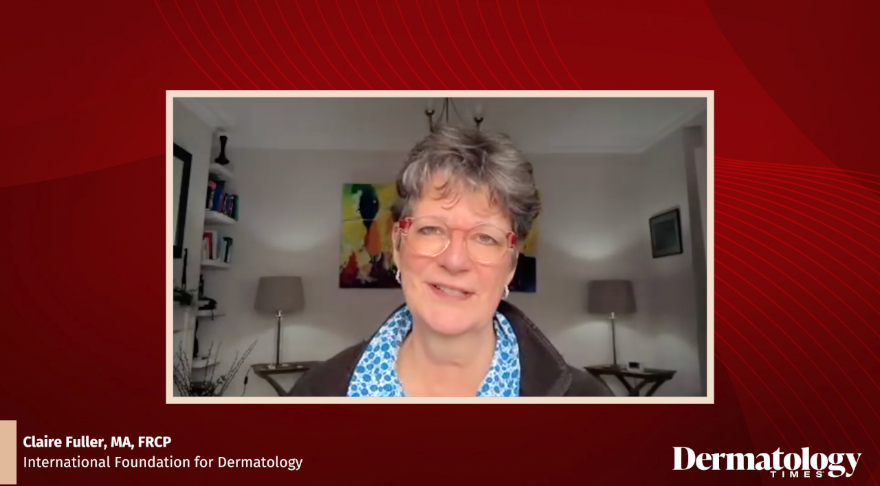Earlier this summer, in an historic step for global dermatology, the World Health Assembly (WHA) passed its first-ever resolution on skin disease, recognizing skin health as a global public health priority.1
Dermatology Times spoke with Claire Fuller, MA, FRCP, a consultant dermatologist and chair of the International Foundation for Dermatology (IFD), to understand the implications of the landmark resolution and the urgent work still needed to advance access, equity, and innovation in skin health worldwide.
“This is an absolute game changer for skin health worldwide,” Fuller said. “It gives us a visa, if you will, to be able to go and talk to our member states’ ministers of health to say, ‘Look, you’ve signed up to this. How can we help you deliver it?’”
Dermatology’s Representation in the WHO
While skin conditions remain among the most common diseases globally,2 dermatology has historically lacked formal representation at the World Health Organization (WHO). Fuller explained that until now, no WHO department, unit, or dedicated officer focused on dermatology or skin disease.
“There is no dermatology department, no dermatologist, no emphasis or unit within the World Health Organization that considers dermatology,” Fuller noted. Instead, the only consistent dermatologic voice at the WHO has been through the International League of Dermatological Societies (ILDS), which is the sole non-state actor in official relations with WHO focused on skin disease.
For the past 2 decades, the ILDS and its humanitarian arm, the IFD, have worked to raise the profile of skin health across WHO departments, including neglected tropical diseases, essential medicines, noncommunicable diseases, and even climate change.
“We do have a real opportunity as non-state actors in official relations to be able to raise issues of skin health at the WHO level, but without much of a mandate,” she added.
A New Global Mandate for Skin Health
Adopted in May, the new WHA resolution marks the first formal recognition of skin diseases in the organization’s 78-year history. The resolution calls on member states, global stakeholders, and the WHO itself to elevate skin health within their public health strategies.
Key recommendations include:
- Developing national skin health policies
- Integrating skin care into primary health systems
- Reducing stigma associated with skin conditions
- Expanding training and credentialing for frontline health care workers
- Building dermatologic leadership at the national level
“Priority steps would be to encourage member states… to draft or develop a national policy for common skin disease,” Fuller said. “That framework might include a recommendation to circulate learning materials that are already available, making sure that they are accessible to their frontline health care workers.”
She emphasized the need for education programs that embed dermatology into primary care training and ensure health workers are both credentialed and motivated to diagnose and manage common skin conditions.
Addressing Global Access and Workforce Gaps
The resolution also sheds light on disparities in dermatologic care. Fuller cited countries where access is virtually nonexistent.
“In the Solomon Islands, a population of around 900,000, there are currently no dermatologists. In Papua New Guinea, a population of 11 million, there are 2 dermatologists. In the Gambia, there are 24 million people and no dermatologists,” she said.
Even in wealthier nations with many dermatologists, distribution is uneven. “There are islands of urban concentration, but rural areas effectively have no access,” she noted, referencing stark geographic gaps in the US and Brazil.
To combat this, Fuller urges countries to identify national dermatology leaders and invest in regional training.
Moving From Resolution to Action
Now that the resolution is passed, Fuller emphasized that the hard work begins: coordination, policy-making, and implementation at the country level.
“[Leaders] can come together and coordinate action around the areas that they’ve been commanded to do in the resolution,” she said. That includes advocacy, leadership development, integration of care, stigma reduction, and curriculum building.
References
- Member states adopt landmark resolution on skin diseases at 78th World Health Assembly. News release. GlobalSkin. May 24, 2025. Accessed July 21, 2025. https://globalskin.org/component/content/article/78-gs-2019-content/649-member-states-adopt-landmark-resolution-on-skin-diseases-at-78th-world-health-assembly?Itemid=1710
- Seth D, Cheldize K, Brown D, Freeman EF. Global burden of skin disease: inequities and innovations. Curr Dermatol Rep. 2017;6(3):204-210. doi:10.1007/s13671-017-0192-7
